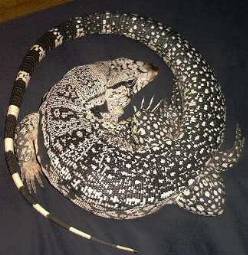- Blue Tegu
Taxobox
name = Blue Tegu

image_width = 200px
image_caption = An immature blue tegu resting
regnum =Animal ia
phylum = Chordata
classis = Reptilia
ordo =Squamata
subordo =Sauria
familia =Teiidae
genus = "Tupinambis "
species = "T. merianae"
binomial = "Tupinambis merianae"
binomial_authority = Linnaeus, 1758The Blue Tegu is a smaller tegu, growing to about 1 meter long, renowned for its light blue coloration, which is most intense on adult males. Even immature animals can be easily distinguished from other mostly black and white tegu species by the "singe mark" on their nose. They are among the more suitable tegus for pets, and can be easily tamed but in the wild will either try to run away or react aggressively if provoked. There is much controversy in the hobbyist community about the correct scientific classification of this animal. It is often thought to be a mutation of the
Argentine Black and White Tegu The coloring of a blue tegu can range from an all white animal to a powder blue to even platinum. The color is most vivid on mature males and doesn't really appear until the animal reaches sexual maturity around the age of 18 months.
Just like the
Argentine Black and White Tegu , the blue tegu has a very quick growth rate, almost reaching its full length in a year. Their length varies from 2.5 feet in females to close to 4 feet in adult males. Unlike other lizards these are very heavily built animals ranging from 7 to 12 pounds when fully grown.Housing
To accommodate their size, a lone adult should be housed in nothing smaller then a 6'x3'x2' size cage, with the largest floor size possible. For a pair, 6'x4' floor space is alright but bigger is always better. About a foot of mulch should be used to allow for burrowing and to help keep humidity up.
A good UVA and UVB bulb really helps with the raising of these animals. Some people have done it without a light but it's one of those things where its better to have one and not need it than be without one and need it. Along with UV a blue tegu also needs the basic heating and basking with a basking temp being around 43C (110F).
Like most lizards, fresh water should be provided daily.
Feeding
These tegus are almost strictly meat eaters, most like various feeder insects like mealworms, supper worms, earth worms, silkworms, crickets and roaches. They also eat mice, rats, ground turkey, crayfish, dog food (not recommended), rabbit, chicks and eggs. A varied diet will keep a blue's interest but they often have favorites and as adults stick to one food type.
Variations
There are many different shades of blue and as hatchlings it's hard to tell what they'll look like when they grow up. However, the Blue Tegu does offer something unique when it comes to tegus, they come in an Albino and Snow phase. The Snow phase is a tegu that is completely white, there is no pattern or red eyes to it.
External links
* [http://www.tegutalk.com/ TeguTalk.com: Reptile Forums and Chatroom] (Owned and operated by Bobby Hill of Varnyard Herps, Inc.)
* [http://www.varnyard-herps-inc.com/ Varnyard Herps, Inc.com: Home of the Dog Tame Tegus] (Care and advice for Extreme Giant Tegus, High contrast Argentine Red Tegus and Argentine Black and White Tegus)
Wikimedia Foundation. 2010.
